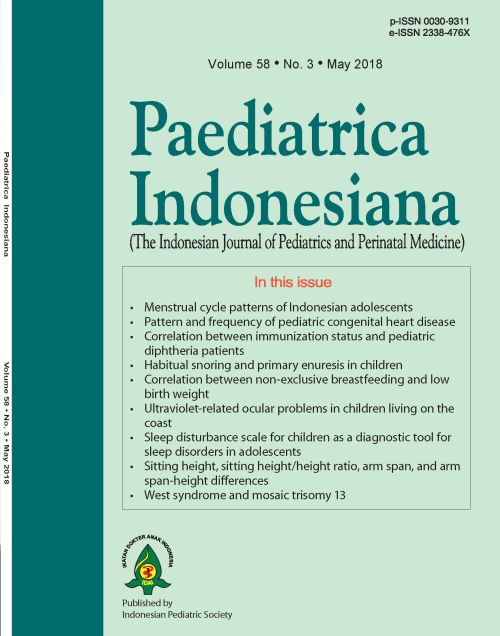Sleep disturbance scale for children as a diagnostic tool for sleep disorders in adolescents
DOI:
https://doi.org/10.14238/pi58.3.2018.133-7Keywords:
Sleep Disturbance Scale for Children, adolescent, sensitifity, spesifityAbstract
Background. Sleep is an essential needs for every children. Sleep may cause a large effect on mental health, emotional, physical and immune system. If sleeping time is not sufficient, then sleep disturbance may occur. Objective assessment of the sleeping quality can be done by using Polysomnography and Actigraphy, while for assessing the subjectivity of sleeping quality and quantity can be used questionnaires or interviews. Sleep Disturbance Scale for Children or SDSC is a multidimensional sleeping assessment questionnaire.
Objective. To determine the quality of sleeping in adolescents using SDSC.
Methods. We conducted a diagnostic test study using cross sectional method, during March to April 2015 at the elementary schools in manado. The inclusion criteria were healthy adolescent aged 10 to 12 years, the parents were willing to sign the informed consent and answer the questionnaire, agreed to attach the wristactigraph. All datas were analyzed using chi square test and table 2 x 2 to showed sensitivity, specificity, positive predicitive value and negative predictive value.
Results. Of 60 adolescents, 31 were female and 29 were male with the mean age 11.39 years. The results showed the sensitivity of SDSC was 80.6%, the specificity was 37.9%, the positive predictive value was 58.1% and negative predictive value was 64.7%.
Conclusions. Sleep Disturbance Scale for Children is a good screening tool for early detection of sleep disorders in a adolescent.
References
Tanjung MFC, Sekartini R. Masalah tidur pada anak. Sari Pediatri. 2004;6:138-42.
Thiedke CC. Sleep disorders and sleep problems in childhood. Am Fam Physician. 2001;63:227-84.
Pardede N. Masa remaja. In: Narendra MB, penyunting. Buku ajar tumbuh kembang. edisi 1.Jakarta;sagung seto. 2010.h.138.
Sekartini R, Dhamayanti M, Hartanto F, Sofyani S, Sitaresmi M, Lestari H. Prevalensi gangguan tidur pada remaja menggunakan kuesioner sleep disturbance scale for children di beberapa kota besar di Indonesia. Unit Kerja koordinasi Tumbuh Kembang - Ikatan Dokter Anak Indonesia. 2009.
Departemen Kesehatan RI. Laporan Nasional riset kesehatan dasar 2007. Jakarta. Badan penelitian dan pengembangan kesehatan, 2008.
Kahn A, Franco P, Groswasser J, Scaillet S, Kelmanson I, Kato I. Sleep characteristics and sleep deprivation in infants, children and adolescence. WHO Technical Meeting on Sleep and Health. 2004. [accessed 26 desember 2013]. Available at http://www.euro.who.int/document/ E84683_1.pdf.
Soetjiningsih. Pertumbuhan somatic pada remaja. In: Soetjiningsih, penyunting. Tumbuh kembang remaja dan permasalahannya. Cetakan ke 2. Jakarta: Sagung seto; 2007.p.1-3.
Bruni O, Ottaviano S, Guidetti V, Romoli M, Innocenzi M, Cortesi F. The Sleep Disturbance scale for Children (SDSC). Construction and validation of an instrument to evaluate sleep disturbances in childhood and adolescence. J Sleep Res.1996;5:251-61.
Romeo DM, Bruni O, Brogna C, Ferri R, Galluccio C, De Clemente V. Application of the sleep disturbance scale for children (SDSC) in preschool age. Eur J Paediatr Neurol. 2013;17:374-82.
Natalita C, Sekartini R, Poesponegoro H. Skala Gangguan Tidur untuk Anak (SDSC) sebagai Instrumen Skrining Gangguan Tidur pada Anak Sekolah Lanjutan Tingkat Pertama. Sari Pediatri. 2011;12:365-72.
Saffari M, Gholamrezaei A, Saneian H, Attari A, Bruni O. Linguistic validation of the Sleep Disturbance Scale for Children (SDSC) in Iranian children with Persian language. Sleep Med. 2014;15:998-1001.
Morgenthaler T, Alessi C, Friedman L, Owens J, Kapur V, Boehlecke B. Practice Parameters for the Use of Actigraphy in the Assessment of Sleep and Sleep Disorders: An Update for 2007. Standards of Practice Committee of the American Academy of Sleep Medicine. Sleep. 2007;30: 519-29.
Chung K, Cheung M. Sleep-Wake patterns and sleep disturbance among Hong Kong Chinese adolescents. Sleep. 2008;31:185-94.
Yang CK, Kim JK, Patel SR, Lee JH. Age related changes in sleep/wake pattern among korean teenagers. Pediatrics. 2005;115:250-56.
Haryono A, Rindiarti A, Arianti A, Pawitri A, Ushuluddin A, Setiawati A. Prevalensi Gangguan Tidur pada Remaja Usia 12 – 15 tahun di Sekolah Lanjutan Tingkat Pertama. Sari Pediatri. 2009;11:149-54.
Hysing M, Pallesen S, Stormark K, Lundervold A, Sivertsen B. Sleep pattern and insomnia among adolescent: a population based study. J Sleep Res. 2013;22:549-56.
Dohnt H, Gradisar M, Short M. Insomnia and its symptoms in adolescent: comparing DSM-IV and ICSD-II diagnostic criteria. J Clin Sleep Med. 2012;8:295-9.
Cain N, Gradisar M. Electronic media use and sleep in school-aged children and adolescents: a review. Sleep Med. 2010;11:735-42.
Dohnt H, Gradisar M, Short M. Insomnia and its symptoms in adolescent: comparing DSM-IV and ICSD-II diagnostic criteria. J Clin Sleep Med. 2012;8:295-9.
Downloads
Published
How to Cite
Issue
Section
License
Authors who publish with this journal agree to the following terms:
Authors retain copyright and grant the journal right of first publication with the work simultaneously licensed under a Creative Commons Attribution License that allows others to share the work with an acknowledgement of the work's authorship and initial publication in this journal.
Authors are able to enter into separate, additional contractual arrangements for the non-exclusive distribution of the journal's published version of the work (e.g., post it to an institutional repository or publish it in a book), with an acknowledgement of its initial publication in this journal.
Accepted 2018-06-07
Published 2018-06-08


















